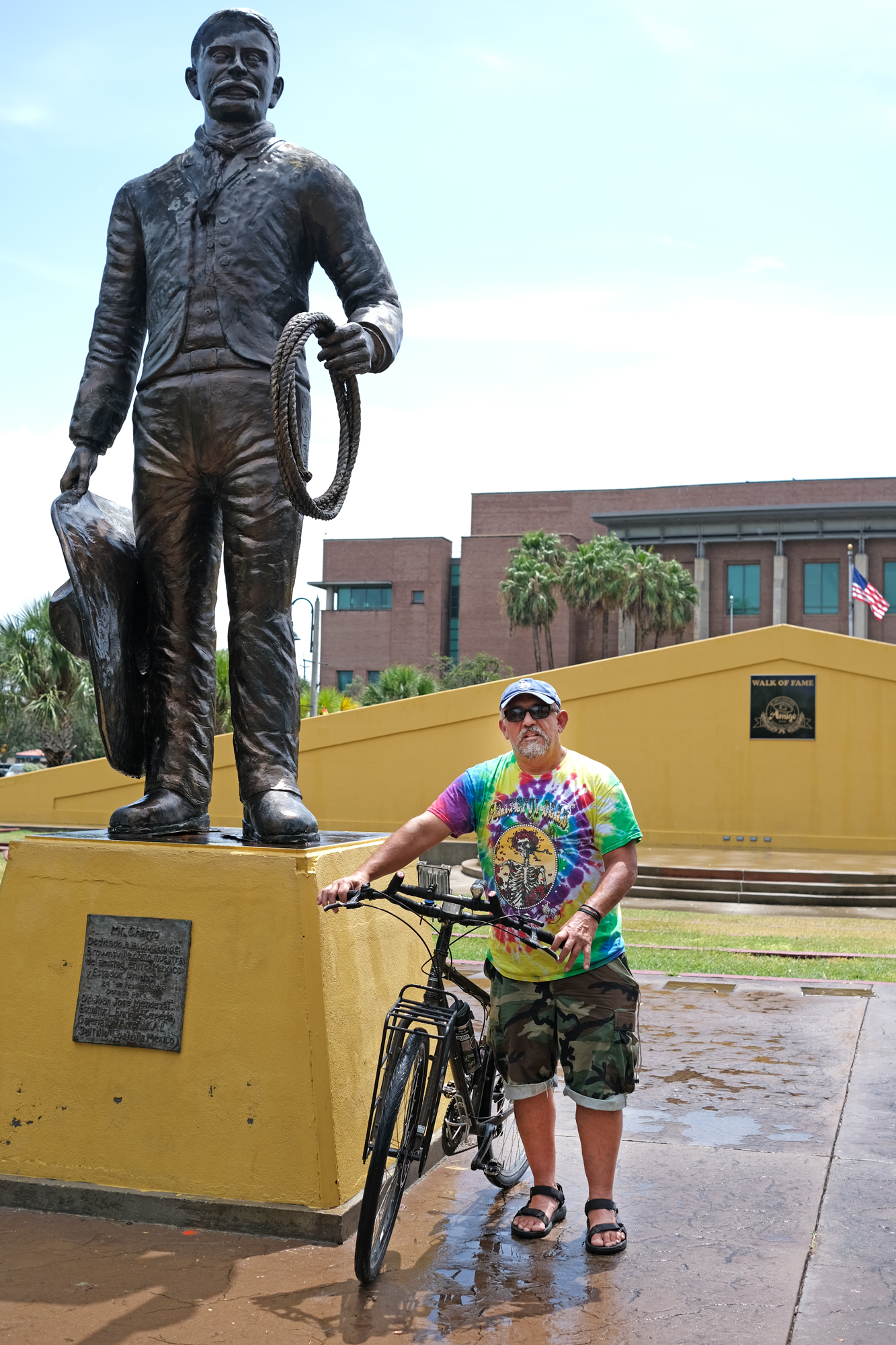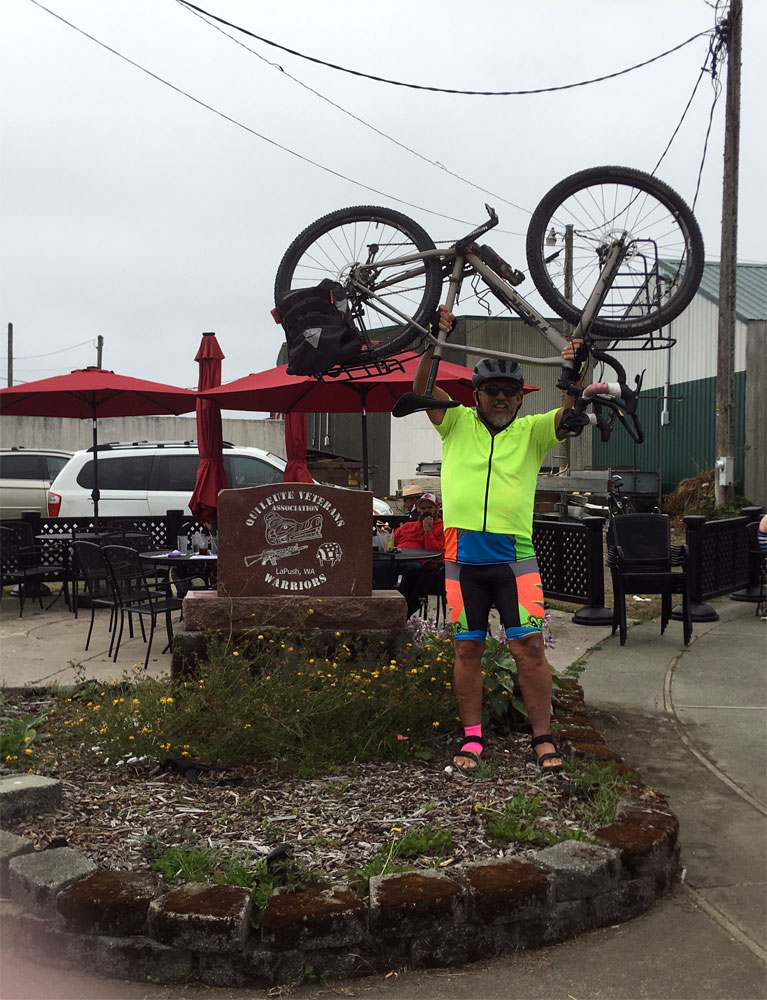Sometimes a ride is more than just a ride.
Just ask Joe De La Garza, a local biking enthusiast who was among five combat veterans chosen to take part in a cross-country trek from Washington D.C. to Washington along the Great American Rail Trail.
The ride was organized by Warrior Expeditions, a nonprofit outdoor therapy group that helps veterans make the transition from their wartime experiences via long-distance biking, hiking and paddling trips. De La Garza, a La Feria native now retired and living in Laguna Vista, was chosen along with the four others out of 400 applicants.
He served in both the Army and the Navy at different times, starting as a reservist in the 1980s and serving on active duty from 1993 through 1996. Nearly a decade later he was called back for active duty as a Navy corpsman, spending his 40th birthday overseas. De La Garza embarked on the coast-to-coast ride on May 26 and arrived in La Push, Wash., the trail’s western terminus, on Aug. 15.
The Great American Rail Trail (GART) is an ongoing project of the national Rails-to-Trails Conservancy, which has also lent its support to the Caracara Trail project under development to connect communities across Cameron County. De La Garza’s group started together but each rode at his own pace. The last rider was still about 10 days out from finishing when De La Garza was interviewed on Aug. 26.
The leg from Washington D.C. to Pittsburgh, Penn., was easy thanks to the C&N Canal Towpath Trail and the Great Allegheny Passage Trail, though much of the rest of the journey involved sharing the road with cars and trucks, he said. GART is 3,817 miles long from end to end, not counting off-route trips to for supplies, lodging and so on.
De La Garza said one of his favorite things about the trip was seeing small-town downtowns in the process of being revitalized, but especially the Little League ballgames he’d come upon from time to time.
“I’d be riding and see a ballgame,” he said. “I’d pull over and I’d watch a baseball game.”

De La Garza had also hoped to catch a major league game or two along the way, though his timing was a little off.
“The Dodgers are my team, but I didn’t get to see them because I was two days ahead,” he said.
Rather than wait two days in Pittsburgh to see the Dodgers play the Pirates, De La Garza pressed on to Chicago with the notion of seeing the Cubs, though the team was on the road. Finally in Seattle his luck turned.
“I caught the Mariners and the Rangers,” De La Garza said. “It was a good game.”
But there were also rough patches along the way, including a few instances of racism he encountered plus a nasty wreck that left De La Garza with permanent scars.
“I took a spill at about 40 mph coming down a hill around a blind curve,” he said.
The Warrior Expeditions screening process is meant to ensure that the veterans selected for an adventure are up for it physically as well as mentally, and it probably didn’t hurt that De La Garza has spent most of his life on a bike of one type or another.
“I’ve been biking pretty much all my life,” he said. “I never stopped, from the BMX days to mountain biking when it first started, then Rails-to-Trails here in the (Rio Grande) Valley when we first started petitioning for it. When I was in the military I rode a bicycle. I’ve always enjoyed it.”
GART wasn’t his first cross-country ride. De La Garza’s previous bike tours include the 237-mile Katy Trail that stretches across much of Missouri. He spent a month riding that trail up and down, stopping in at small towns along the way. Another of De La Garza’s favorite experiences on the GART trip involved something called “trail magic,” which tends to be concentrated in communities that place a high value on the trail and its travelers.
Trail magic can come in the form on anonymous ice chest full of cold Cokes, or businesses giving away ice cream to tired riders. De La Garza got the chance to spread a little trail magic of his own toward the end of his ride, when his wife joined up with him and followed behind him in her car for the final leg into La Push, on the western coast of the Olympic Peninsula.
“I ran into a young couple and they were going the opposite direction and they were just crossing Washington,” he said. “They were exhausted. I could see it, because I’ve done it. He was carrying this big rope and I said what do you got that rope for?”
The man explained that the rope was to tie up their food while camping so bears wouldn’t get it, a valid concern in those parts, though the rope was needlessly heavy. De La Garza gave him his own coil of lightweight “550 cord,” the all-purpose, go-to line for seasoned campers. But the magic wasn’t done.
“We did get them a hotel room for that night,” De La Garza said. “I said, ‘You know what? I’ve experienced trail magic this whole way. Now you’re going to experience it.’ “
And still the magic wasn’t done; someone else picked up the couple’s restaurant tab that night, he said.

“Somebody else had done trail magic for them,” De La Garza said. “You experience stuff like that along the way.”
Although he was on his own on the trail after the group dispersed, he wasn’t alone, thanks to the “ghosts” he carries as a result of his physical and psychological combat injuries, he said.
“This ride was part of that, to let some of that go,” he said.
In the old days warriors walked home after a war, often for months, and by the time they had reached home they had “walked it all out,” De La Garza said. In modern times a warrior can be on the field of battle 6,000 miles away one day and then back in their hometown in the United States less than 24 hours later — a terribly difficult adjustment.
So the ride was good too in the mental health sense — in fact it was the best part, De La Garza said. It’s because of that and the other positive aspects of a comprehensive trail system (including the economic important of outdoor tourism; he shared the GART trail with thousands of other riders, who were spending money in the communities where they stopped) that De La Garza is a major proponent of the Caracara Trail project that will eventually connect about a dozen Cameron County communities along a 428-mile trail network.
Meanwhile, he’s already planning his next adventure.
“I’m looking forward to the next challenge,” De La Garza said. “I’m starting here in the Rio Grande Valley at the border and I’m going to end up at the Canadian border. … I’m hoping to start next spring, and I want to invite the people of the Valley to get behind me like they did on this other one and support me with positive messages and this and that.
“If they want to train with me locally I’ll be training locally and I want to highlight what we have here, because what we have here is a true gem. It’s just many times we don’t appreciate what we have in our own backyard.”




